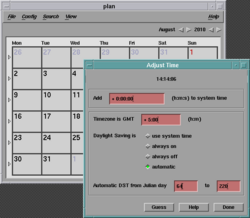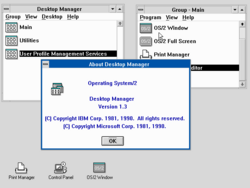Presentation Manager
Presentation Manager (PM) is the graphical user interface (GUI) that IBM and Microsoft introduced in version 1.1 of their operating system OS/2 in late 1988.
History
Microsoft began developing a graphic user interface (GUI) in 1981. After it persuaded IBM that the latter also needed a GUI,[1] Presentation Manager (PM; codenamed Winthorn) was co-developed by Microsoft and IBM's Hursley Lab in 1987-1988. It was a cross between Microsoft Windows and IBM's mainframe graphical system (GDDM).[2] Like Windows, it was message based and many of the messages were even identical, but there were a number of significant differences as well. Although Presentation Manager was designed to be very similar to the upcoming Windows 2.0 from the user's point of view, and Presentation Manager application structure was nearly identical to Windows application structure, source compatibility with Windows was not an objective. For Microsoft, the development of Presentation Manager was an opportunity to clean up some of the design mistakes of Windows.[3] The two companies stated that Presentation Manager and Windows 2.0 would remain almost identical.[1]
One of the most significant differences between Windows and PM was the coordinate system. While in Windows the 0,0 coordinate was located in the upper left corner, in PM it was in the lower left corner. Another difference was that all drawing operations went to the Device Context (DC) in Windows. PM also used DCs but there was an added level of abstraction called Presentation Space (PS). OS/2 also had more powerful drawing functions in its Graphics Programming Interface (GPI). Some of the GPI concepts (like viewing transforms) were later incorporated into Windows NT. The OS/2 programming model was thought to be cleaner, since there was no need to explicitly export the window procedure, no WinMain, and no non-standard function prologs and epilogs.
Parting ways
One of the most-cited reasons for the IBM-Microsoft split was the divergence of the APIs between Presentation Manager and Windows, which was probably driven by IBM. Initially, Presentation Manager was based on Windows GUI code, and often had developments performed in advance, like the support for proportional fonts (which appeared in Windows only in 1990). One of the divergences regarded the position of coordinate (0,0), which was at the top-left in Windows, but at bottom-left (as in Cartesian coordinates) in Presentation Manager. In practice it became impossible to recompile a GUI program to run on the other system; an automated source code conversion tool was promised at some point. Both companies were hoping that at some point users would migrate to OS/2.
In 1990, version 3.0 of Windows was beginning to sell in volume, and Microsoft began to lose interest in OS/2 especially since, even earlier, market interest in OS/2 was always much smaller than in Windows.
The companies parted ways, and IBM took over all of subsequent development. Microsoft took OS/2 3.0, which it renamed Windows NT; as such, it inherited certain characteristics of Presentation Manager. IBM continued to develop Presentation Manager. In subsequent versions of OS/2, and derivatives such as ArcaOS, it was used as a base for the object-oriented interface Workplace Shell.
There is a significant integration of the GUI layer with the rest of the system, but it is still possible to run certain parts of OS/2 from a text-console or X window, and it is possible to boot OS/2 into a command-line environment without Presentation Manager (e.g. using TSHELL[4] ).
Presentation Manager for Unix

In the late 1980s, Hewlett-Packard and Microsoft collaborated on an implementation of Presentation Manager for Unix systems running the X11 windowing system.[5] The port consisted of two separate pieces of software - a toolkit, window manager and style guide named CXI (Common X Interface) and an implementation of the Presentation Manager API for Unix named PM/X. Both CXI and PM/X were submitted to the Open Software Foundation for consideration as OSF's new user interface standard for Unix, which eventually became Motif.[6] OSF ultimately selected CXI, but used Digital Equipment Corporation's XUI API instead of PM/X.[7][8] Microsoft and HP continued the development of PM/X for some time after the release of Motif, with Microsoft integrating the product into a joint development strategy with SCO to bring a common user interface to OS/2 and SCO's Unix products,[9] but it was ultimately abandoned.[10]
Technical details
PM follows the Common User Access interface conventions. It also supports mouse chording for copying and pasting text.
An important problem was that of the single input queue: a non-responsive application could block the processing of user-interface messages, thus freezing the graphical interface. This problem has been solved in Windows NT, where such an application would just become a dead rectangle on the screen; in later versions it became possible to move or hide it. In OS/2 it was solved in a FixPack, using a timer to determine when an application was not responding to events.
See also
References
- ↑ 1.0 1.1 Alsop, Stewart II (1988-01-18). "Microsoft Windows: Eclectism in UI". P.C. Letter 4 (2): 6–7. http://vintagecomputer.net/cisc367/PC-Letter_19880118.pdf.
- ↑ Miller, Michael J. (April 1987). "IBM's OS/2 to Become Operating System of Choice, but Not for Some Time". InfoWorld: 46.
- ↑ Vellon, Manny (1987). "OS/2 Windows Presentation Manager". Microsoft Systems Journal 2 (2).
- ↑ "TSHELL non-GUI shell for OS/2". http://www.os2site.com/sw/ews/tshell.txt. Retrieved 17 April 2011.
- ↑ Bob Ponting (1988-11-21). "Unix PM Scheduled for 2nd Quarter". InfoWorld. https://books.google.com/books?id=AToEAAAAMBAJ.
- ↑ Martin Marshall; Ed Scannell (1988-10-10). "OSF Narrows Its Search For User Interface to 23". InfoWorld: p. 45. https://books.google.com/books?id=szsEAAAAMBAJ.
- ↑ Janet Dobbs (August 1989). "Strategies for Writing Graphical UNIX Applications Productively and Portably". AUUG Newsletter 10 (4): 50. https://www.tuhs.org/Archive/Documentation/AUUGN/AUUGN-V10.4.pdf. Retrieved 2021-12-29.
- ↑ "Making Interface Behavior Consistent: The HP OSF/Motif Graphical User Interface". June 1990. https://worldradiohistory.com/Archive-Company-Publications/HP-Journal/90s/HPJ-1990-06.pdf.
- ↑ Mace, Scott (20 February 1989). "Microsoft Says It Will Purchase Portion Of SCO". InfoWorld: 5. https://archive.org/details/bub_gb_JzoEAAAAMBAJ/page/n4/mode/1up. Retrieved 3 January 2024.
- ↑ Stuart J. Johnson (January 1989). "HP, Microsoft to Continue Development of Alternate API". InfoWorld: p. 38. https://books.google.com/books?id=KzoEAAAAMBAJ.
External links
- IBM Corporation (Oct 1994). Presentation Manager Programming Guide: The Basics. http://bitsavers.informatik.uni-stuttgart.de/pdf/ibm/pc/os2/warp_ver_3/G25H-7103-00_OS2_WARP_V3_Presentation_Manager_Programming_Guide_The_Basics_Oct94.pdf. Retrieved 28 April 2017.
- IBM Corporation (Oct 1994). Presentation Manager Programming Guide: Advanced Topics. http://bitsavers.informatik.uni-stuttgart.de/pdf/ibm/pc/os2/warp_ver_3/G25H-7104-00_OS2_WARP_V3_Presentation_Manager_Programming_Guide_Advanced_Topics_Oct94.pdf. Retrieved 28 April 2017.
- IBM Corporation (Oct 1994). Presentation Manager Programming Reference Volume 1. http://bitsavers.informatik.uni-stuttgart.de/pdf/ibm/pc/os2/warp_ver_3/G25H-7190-00_OS2_WARP_V3_Presentation_Manager_Programming_Reference_Volume_1_Oct94.pdf. Retrieved 28 April 2017.
- IBM Corporation (Oct 1994). Presentation Manager Programming Reference Volume 2. http://bitsavers.informatik.uni-stuttgart.de/pdf/ibm/pc/os2/warp_ver_3/G25H-7191-00_OS2_WARP_V3_Presentation_Manager_Programming_Reference_Volume_2_Oct94.pdf. Retrieved 28 April 2017.
 |



